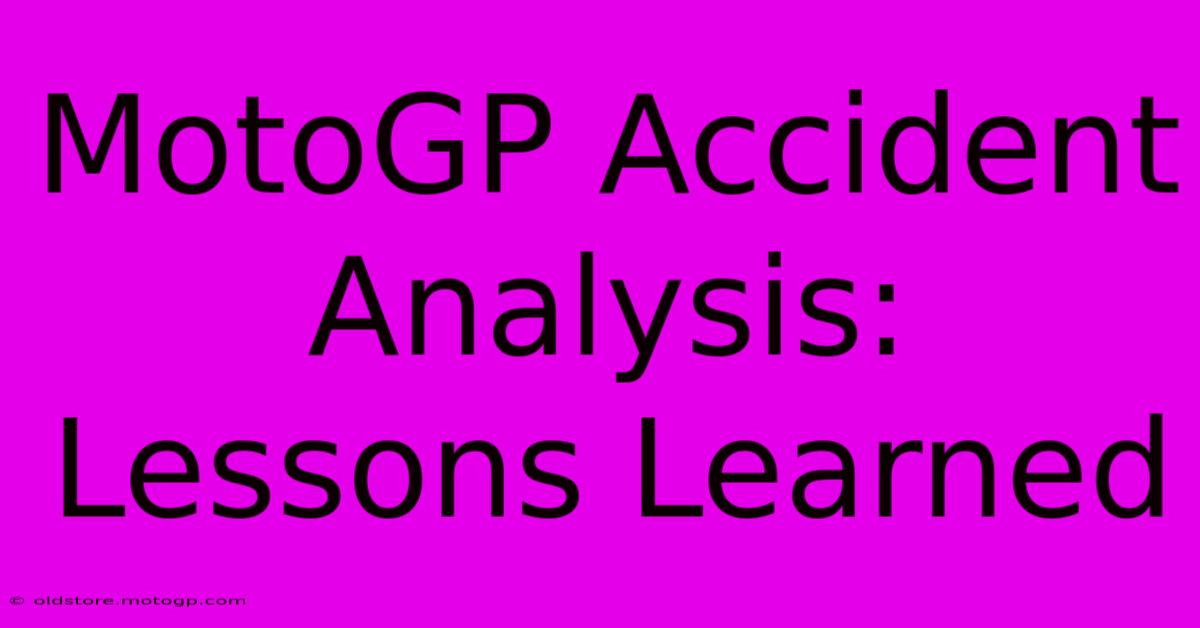MotoGP Accident Analysis: Lessons Learned

Table of Contents
MotoGP Accident Analysis: Lessons Learned
MotoGP, the pinnacle of motorcycle road racing, is a thrilling spectacle of speed, skill, and precision. However, the high speeds and intense competition inevitably lead to accidents. Analyzing these incidents is crucial not only for improving rider safety but also for enhancing the sport's overall safety protocols and technological advancements. This article delves into the analysis of MotoGP accidents, highlighting the lessons learned and the ongoing efforts to minimize risks.
Understanding the Causes of MotoGP Accidents
MotoGP accidents are multifaceted, stemming from a complex interplay of factors. Categorizing these causes helps in targeted safety improvements.
1. Rider Error: A Significant Factor
Human error remains a leading contributor to accidents. This encompasses various aspects:
- Pushing the Limits: The inherent nature of racing necessitates pushing machines and riders to their limits. Overconfidence, fatigue, or momentary lapses in judgment can lead to mistakes.
- Incorrect Line Choices: Choosing the wrong racing line, especially during overtaking maneuvers or in challenging corners, can result in collisions or crashes.
- Loss of Control: Sudden changes in track conditions (e.g., oil spills, wet patches) or unexpected rider inputs can cause a loss of control, leading to accidents.
2. Mechanical Failures: A Threat to Safety
Mechanical issues, although less frequent than rider error, can have devastating consequences:
- Tire Failures: Tire blowouts or loss of grip due to tire degradation are significant risks, especially at high speeds.
- Brake Failures: Loss of braking power can render a rider helpless, resulting in a high-speed crash.
- Engine Failures: Engine malfunctions, while less common due to stringent regulations and advanced technology, can lead to unexpected loss of power and control.
3. Track Conditions: An Unpredictable Variable
Track conditions play a crucial role in accident occurrence:
- Weather Conditions: Rain, especially sudden downpours, significantly reduces grip, making racing extremely hazardous.
- Track Surface: Degraded asphalt, oil spills, or debris on the track can compromise rider control and increase the risk of crashes.
Analyzing Accidents: Techniques and Technologies
Effective accident analysis employs a combination of techniques and technologies:
1. Data Acquisition: The Foundation of Analysis
Sophisticated data acquisition systems, embedded in motorcycles and trackside, capture crucial information during a race:
- Telemetry Data: Real-time data on speed, acceleration, braking, lean angle, and throttle position provide valuable insights into the events leading up to a crash.
- Video Analysis: High-speed cameras capture detailed footage of the accident, allowing for frame-by-frame analysis to understand the sequence of events.
2. Simulation and Modeling: Predicting and Preventing
Advanced simulation tools and modeling techniques are used to reconstruct accidents and test various scenarios. This helps in identifying potential risks and improving safety measures.
Lessons Learned and Safety Improvements
Analysis of past MotoGP accidents has led to significant improvements in safety:
- Improved Safety Gear: Advanced protective gear, including stronger helmets, suits, and boots, reduces the severity of injuries in crashes.
- Track Modifications: Track improvements, such as improved run-off areas and safety barriers, minimize the impact of crashes.
- Technological Advancements: Electronic rider aids, such as traction control, anti-lock brakes, and wheelie control, help riders maintain control and avoid accidents.
- Enhanced Medical Care: Improved medical facilities and response times at race tracks significantly improve the chances of rider survival and recovery.
The Ongoing Pursuit of Safety
While significant progress has been made, the pursuit of enhanced safety in MotoGP is an ongoing process. Continuous research, analysis, and technological advancements are essential to minimizing the risks inherent in this demanding sport. The dedication to safety not only protects the riders but also enhances the integrity and appeal of the sport. The lessons learned from every accident drive improvements, pushing the boundaries of safety technology and rider training, ensuring a safer and more exhilarating racing experience.

Thank you for visiting our website wich cover about MotoGP Accident Analysis: Lessons Learned. We hope the information provided has been useful to you. Feel free to contact us if you have any questions or need further assistance. See you next time and dont miss to bookmark.
Featured Posts
-
Why Moto Gp Points Matter
Feb 25, 2025
-
Get Ready To Rumble Austin Gp Sprint Race Excitement
Feb 25, 2025
-
Lot F Cota Achieve Specific Result
Feb 25, 2025
-
Formula One Starting Grid Decoded
Feb 25, 2025
-
Moto Gp Sprintrennen A Spectacle Of Speed And Skill
Feb 25, 2025
